When we talk of woods we are talking mainly about a temperate zone somewhere between the sub-tropical zones and the polar regions.
The temperate zone is subject to considerable fluctuations in temperature between summer and winter, and this needs to be taken into account so you know what to prepare for in terms of shelter, water, food and clothing.
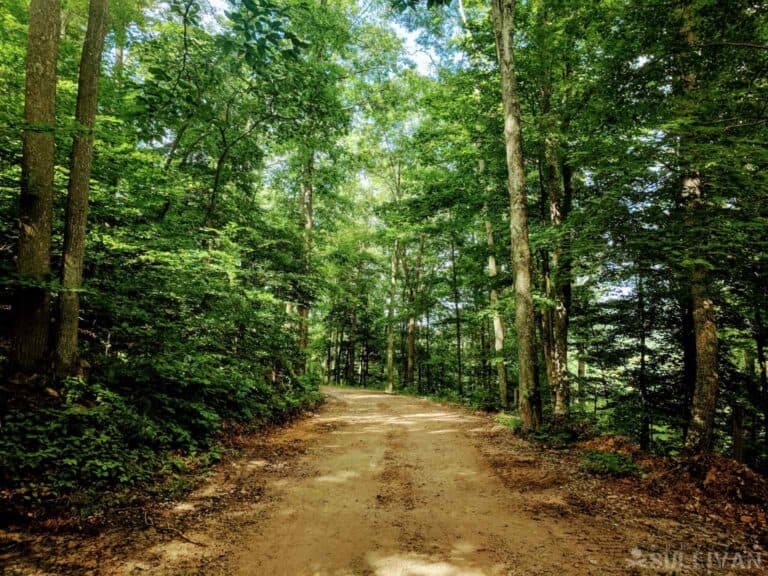
The temperature in the coldest month of the year will be above 26.6 °F / −3 °C and in the warmest months will be above 50.0 °F/ 10 °C according to the Köppen climate classification.
Tropical and sub-tropical zones require some adjustments in terms of surviving, mainly in relation to the food sources available, insect and animal hazards, and coping with the heat. The most important factors are shelter, water, fire, food and avoiding attacks.
Although I truly hope you don’t end up surviving in the woods for any length of time because of the many dangers that await you, here’s what you should know if you ever do.
Table of Contents
Shelter
Surviving in the woods during the cooler months will require a quality sleeping bag and the ability to make some form of shelter, as shelter is your most important consideration.
Should it be summer and clear weather then it’s not such a big issue. But without proper shelter in colder weather hypothermia can set in and it will take only a few hours before a person dies.
You will need a good quality three season sleeping bag that is designed to last for years with a sleeping bag liner that you can take out and wash, so saving your sleeping bag, and also providing a little extra warmth should you need it.
If you are planning on surviving in the woods for some time then a lightweight tent or a bivvy may be a good idea.
It all depends on whether you want to go absolutely minimal – in which case you probably will need only two blades – a small knife and a large knife, and will get by with using leaves and pine branches for constructing something to keep you warm.
Some people may prefer to find a cave or rock overhang for shelter, assuming a bear or other large creatures haven’t found it already.
Surviving in the woods shouldn’t be an uncomfortable experience, and if a few extras can keep you comfortable without adding too much weight to your back pack then why not? Keeping dry is important, and even for a short stay a tarp can be very useful as a lightweight one can fold up quite small.
If you plan on surviving in the woods for longer periods you will probably want to start constructing a rudimentary shelter or cabin, but keep the tarp – it will come in useful in many ways from catching rain water to covering firewood, or creating an animal trap.
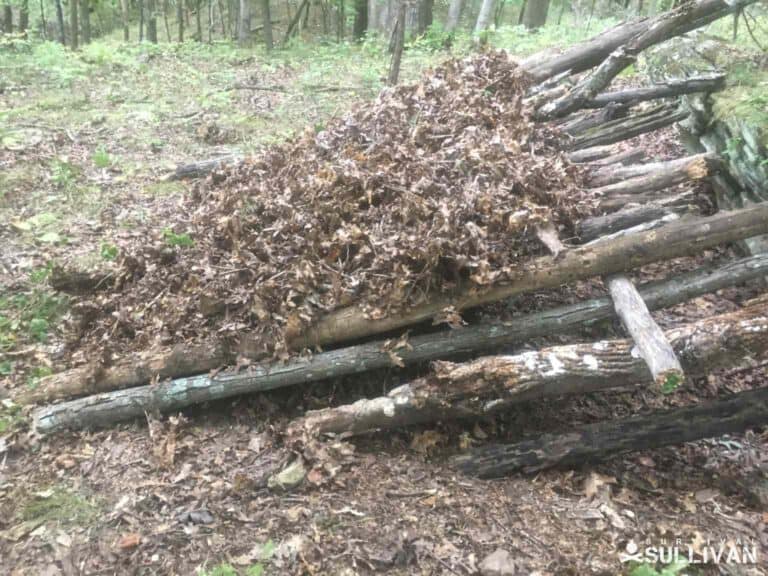
Creating a Quick Survival Shelter
One crucially important skill to have when surviving in the woods, in any region and in any climate, is knowing how to rapidly construct a survival shelter.
Sometimes the weather takes a turn for the worst when least expected, and when you can least afford it.
Other times you might end up in trouble because of an accident, like falling through ice or taking a tumble into a creek or river. Whatever the case, the ability to create a microclimate as quickly as possible is essential.
The clock will definitely be ticking, and as your hands and fingers become debilitated by cold, and your core temperature plummets, the chances of successfully setting up a tent, bivvy and so forth dwindle.
It might be enough (and all you can do) to climb inside your sleeping bag inside a fluffy stack of pine boughs.
That’s just an example though. You might be able to make a quick survival shelter by tunneling into a snow drift or some other method, but what matters is that you’re familiar with creating a hasty survival shelter no matter the season and no matter the terrain.
Water Sources
Get water from:
- Streams
- Rock crevices
- Morning dew
- Above ground still
- Below ground still
- Transpiration from leaves
- Snow and ice
Water purification and storage are your next most important items for survival. You will need a metal water container or canteen. Forget plastic as it can split, whereas a metal water bottle is better health wise, and can take a few dents and scrapes.
You should have a metal water canteen with you which will last you through the night should you get lost. The next morning you can proceed to find water. Now if you have a bug out bag you should have water purification tablets or a water filtration system in it.
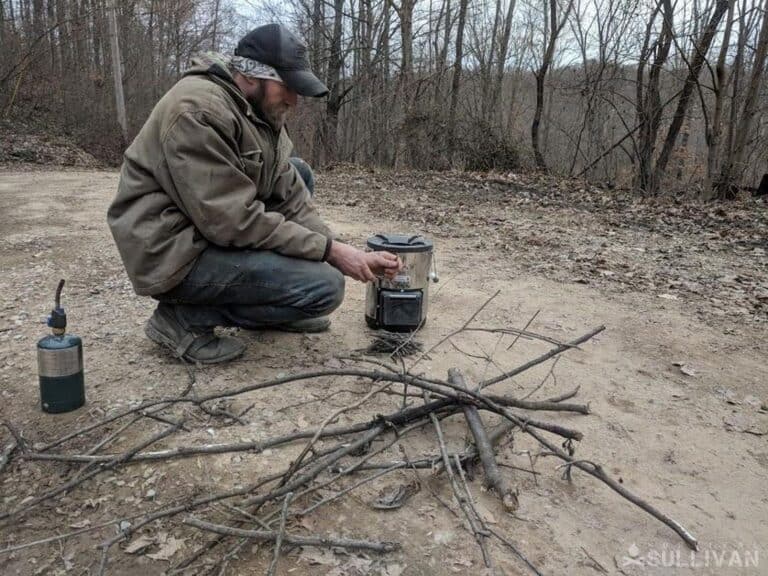
If you plan on surviving for months or even years in the woods you need stuff that will last so you don’t have to go off to the shops to replace items.
In this case, a filtration system or water purification tablets are perhaps not the best idea if you are going to be surviving in the woods for more than a couple of weeks.
You will, instead, need a decent size pot that will last for many years if cared for – preferably cast iron or stainless steel one, that you can use over a fire to boil water. Boiling water kills the pathogens that cause disease.
Now, stainless steel and cast iron can be heavy so these may not be ideal if you are planning on surviving in the woods for extended periods of time, in which case aluminum will be lighter.
Whether you are relying upon a portable water filter or various forms of chemical sterilization, pre-filtering your water is an important concept that you should be implementing regardless.
Unless you have fresh rainfall, clean snow melt or are gathering water off of a pristine glacier, your water will probably have plenty of debris in it in the form of silt and sediment along with larger objects.
Pre-filtering your water through a towel, bandana, mosquito mesh or something similar to remove these larger particles will make purifying your water easier and more certain.
Cloudy, murky water means that your water filter system will have to work harder and will wear out quicker, whereas chemical sterilization methods or even solar disinfection will take much longer and might not get every virus or all the bacteria.
Streams
Collect your water from a faster running section of the stream where the water flows over rocks rather than from a quiet pool.
Rock Crevices / Basins
Watch where the animals, birds and reptiles are heading – there will often be rock crevices and small depressions that collect dew or rainwater in smallish quantities – enough to slake the worst of your thirst.
Morning Dew
One method is to tie a t-shirt around your ankle and walk through the dewy grass in the morning, then wring out the water into a container and repeat until you have enough to slake your thirst. Just make sure you are not walking through a patch of poisonous plants.
Make an above ground still to collect water – you will need a container, an implement to dig with – or you can use your axe for digging, and a tarp or piece of plastic to collect the water. See how it is done here:
Another method for collecting dew is to suspend a tarp at an angle on the hill, funneling it into a container so the dew as it condenses can run off into the container.
After collecting the water can be boiled. The same method can also be used to collect water when there is very light rain, or mist.
Transpiration from Plants
By fastening a plastic bag securely over a branch that has healthy green leaves you will be able to collect water. See how to do it here:
Snow and Ice
Snow and ice are another good emergency water option in the wild. Melt the sheets that form over small puddles in rock pools, or melt snow, and boil before drinking.
Do it at a fairly low temperature otherwise it will not taste good if scorched at high temperatures.
Don’t be tempted to shove snow in your mouth assuming it will melt and be fine – the coldness will lower your body temperature and when you are surviving in the woods you want to keep your body temperature as constant as possible to avoid getting the chills.
And being cold will dehydrate you as your body uses more water in the metabolic process to keep you warm.
Fire
You will need to be able to build a Dakota fire pit in order not to give away your location in the woods. Be aware that if a wind comes up, it will force more air into the hole heating up your fire considerably, and you may need to have something ready to screen the airflow.
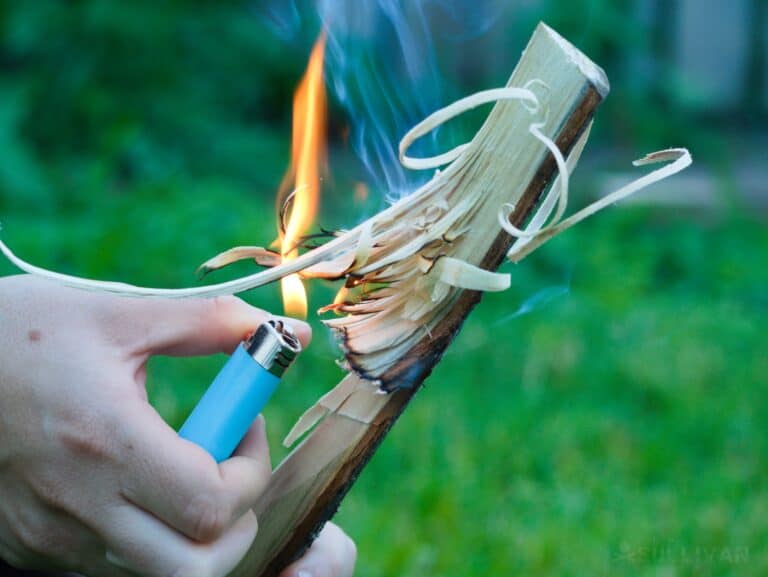
If you don’t need to hide your fire a simple ring of rocks to contain the fire will suffice. An above ground fire is good for radiating heat to keep warm, and heating rocks to wrap and put near your sleeping bag for warmth, or even inside at your feet.
In any fire-making scenario, make sure your fire is properly constructed so you do not risk causing a forest fire.
Always put the fire out at night or, if you need it to be kept going, to ensure wild animals do not get too close then be careful of embers getting stirred up by a night wind and depositing cinders on your sleeping bag, tent or tarp, creating little fires.
I’ve seen it happen! It was a mad scramble for everyone to get water to put out the flames in time.
When it comes to cooking your catch – be it fish, duck, rabbit, or whatever else you have managed to hunt, you can use the skewer method and simply turn the item to be cooked over the fire or you can use heated rocks for cooking:
You will need access to firewood as this is what you will use to heat water for washing yourself, drinking, cooking food, and keeping warm.
In order to survive during the colder months in an off-grid cabin, you’ll need to stockpile wood during the rest of the year, so when you have inclement weather you can still build a fire to cook and keep warm.
If you are planning on moving around, then find places to stockpile your wood – in a cave, or some spot where it can stay dry until you come back to that area.
Fire-Starting Kit
To this end, one of the most important components of your woodland survival kit is going to be your fire making kit. You should have no less than three completely reliable tools in this kit for making sparks or creating flames, along with a supply of good tinder to help you get a fire going.
Matches, lighters, ferro rods and similar tools all have a place, as does good tinder like cotton balls soaked in vaseline, small slices of bicycle inner tube, commercial fire starter and more.
Tinder is what will allow an ember to take hold and persist, igniting your kindling, and is a commonly overlooked element in a fire-making kit.
Also, don’t neglect old school methods of starting fire, as you can rely on these when all other methods are lost or fail.
Starting a friction fire using a bow drill method or similar techniques are as viable (and difficult!) now as they have been for millennia and you should also take it upon yourself to learn how to identify flint, chert and other stones or minerals that can be used to create a spark in conjunction with a steel.
Tools to Survive In the Woods
- Large blade – machete, tomahawk or axe
- Small blade – knife
- Fire starters
- Snare wire
- Paracord
- Fishing kit
- Multitool
- Pot for boiling water
- First-aid Kit
- and more.
When it comes to must-have bushcraft tools you can whittle down the ones you are most likely to need depending on your level of skill.
The ones I would choose would be a small and a large blade, a means to start a fire, snare wire, paracord, a fishing kit and a multitool.
If using an ax or tomahawk ,it should preferably be one that has a wooden handle onto which the head fits so should a handle break you can fashion a new one form wood found in the area.
The above are tools used to create or shape your environment, and do not include other essentials which fall under tools like a flashlight, a pot for boiling water, a mug, and insect repellent.
You don’t have to bring a commercial insect repellent – sage, wormwood and mugwort are all effective if you put them into your fire to create a smoke that will repel insects, or you can rub the fresh crushed leaves from any of these three plants on your skin to deter insects.
Burning sweetgrass is also useful in deterring insects.
Food
Everyone seems to think that hunting is the easiest way to get food, but animals have survived in the woods for thousands of years and haven’t stayed alive while not adapting to the environment. You need to be smarter than them and remember they mostly have keener senses than humans.
This is why snaring smaller animals may be easier than hunting for larger game – and what are you going to do with all that meat if you are on your own without any means to preserve it? Even making biltong or jerky requires bowls, spices, vinegar etc.
Concentrate your efforts on getting fish, maybe shooting ducks, or snaring a rabbit or two to get your protein. Other than that, gather wild edible plants.
Before you even venture out to try surviving in the woods you should have virtually committed to memory a good pocket field guide listing the edible plants, seeds, nuts, and pollen that you can find in your area.
Experience counts for a lot in survival situations, so you should be able to identify edible plants with confidence and know which poisonous ones to avoid.
Trapping
Trapping may be a better option than shooting if you wish to keep your presence in an area from the attention of others. Trapping smaller animals in particular (like squirrels) will be easier than larger ones.
Trapping has a major benefit in that it can allow your efforts to compound.
In a way, it allows you to be in more than one place at a time: once a trap is set, and assuming it does not become fouled or trigger accidentally, it will wait patiently and ceaselessly until it bags your quarry.
Trapping, as you might imagine, does require plenty of skill and insight into animal behavior, and it is very helpful to learn how to identify animal tracks to figure out their trails along with what sort of prey might be in the area.
Despite the difficulty and intricacy of setting up traps, studding an area with many traps is one of the best ways to reliably bring in game over time in a survival scenario.
Foraging
There is plenty to be gathered in the woods – nuts, berries and other edible plants, as well as pollen from cattails, are all available.
However, don’t pass up on the protein just waiting for you – grasshoppers and grubs are there for the taking and will provide some tasty sustenance if correctly prepared.
Roasted termites, boiled ants, grubs on a stick cooked crispy over an open flame… it’s all a matter of getting used to what other people consider quite normal and tasty.
In Thailand, I have watched people settling down in groups at lunchtime to freshly roast takeaway packets of various types of insects the way many of us would devour a packet of crisps during a lunch break.
Fishing
You will need to be able to prepare a primitive fishing kit, have knowledge of how to make a spear for fish or be able to use a gill net in order to catch. You also need to know where the best places fish are hiding are.
Making Primitive Gear
In this video you will see how the aboriginal people of the Northern Territory in Australia make a three pronged spear from a sapling, then bind on the prongs using wire. Using a headlight they fish at night and as you can see are very successful with this primitive tool.
See how to make a primitive fishing kit here using stinging nettle cordage, and thorn hooks:
Shooting for Food
Think twice before bringing down a large animal. We have that atavistic urge to hunt and kill that takes over when an animal presents a good target, but will you be able to use all the meat? Using a gun may advertise your presence if you want to blend into the woods and not let everyone know you are around.
Something else that you might consider, particularly when there is no one else in the area or at least not many people in the area, is that “meat on the hoof” does not spoil.
If you are reasonably sure of your shooting skills, know the area, and know your quarry you might be better off leaving larger game alive until you are sure you need it, or sure that you can preserve it in order to avoid waste.
Food Preparation
When you have planned to survive in the woods for a certain length of time, you can get yourself organized with a Dutch oven in which to prepare stews, a skillet in which to fry your catch – like fresh fish, and hooks on which to suspend food so it can be smoked over a fire.
Most of the time, outdoor cooking will be done over an open fire, but don’t be afraid to experiment – fish caked in clay can be baked in the coals and when the clay is knocked off, the fish skin comes off with it leaving the succulent flesh.
See how to use this ancient method here:
Should you catch quail or other wild fowl, you can use this same method used to coat chicken in clay and bake.
Communications
Should you be lost and need to be reunited with your group, or have become injured due to a fall, a poisonous insect bite, animal or human attack you may need to get help and knowing various methods for communication will be important.
These methods will also help in guiding rescuers to you should you be hopelessly lost:
- Mirror signals
- Flashlights
- Fires
- Whistles
- SOS ground to air
- Leaving a Trail
- Gunshots
- Striking Rocks Together
- Create small boats out of leaves or bark
Mirror signal
A mirror to signal in sunny weather is a small item to carry – very useful for signaling your location, or for communicating with someone you trust from miles away.
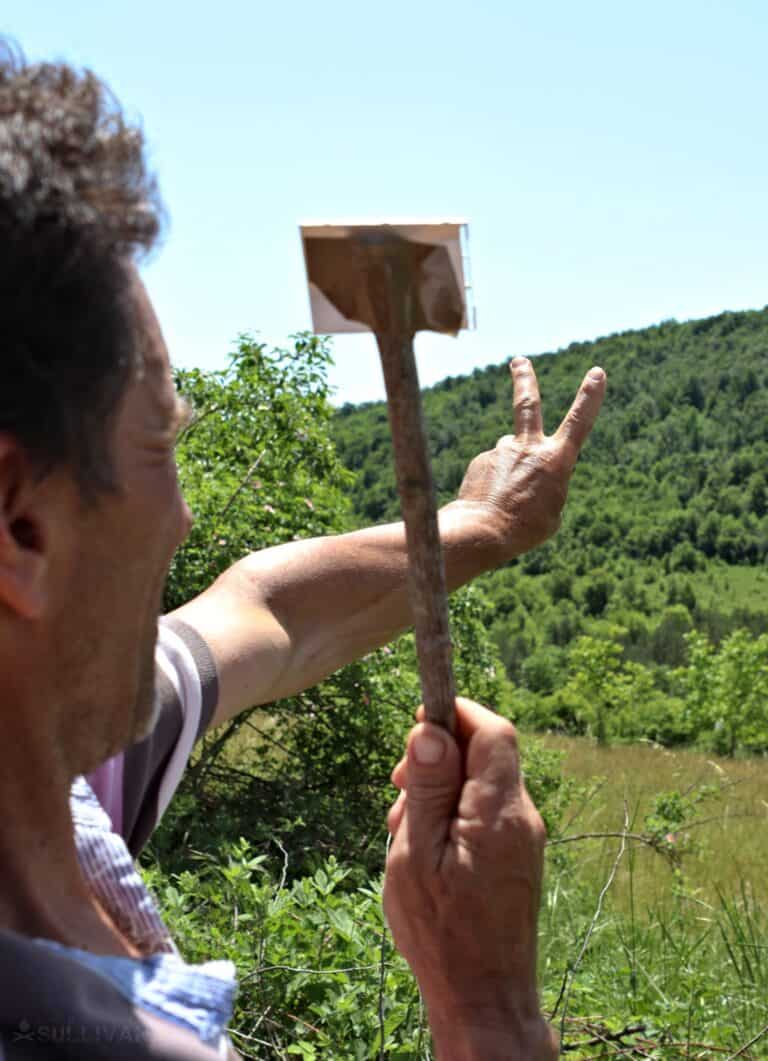
Though it depends entirely on direct sunlight to function, it is nonetheless a great way to signal for rescue across very long distances, and they are so compact and so lightweight there is no reason you shouldn’t have one.
Flashlight
If you are lost at night and need to get attention, flashing the SOS signal with your torch can help guide rescuers.
Lighting Fires
Knowing that three fires in a row is a universal signal for help is useful. Placing green leaves on a fire that is burning well will create plenty of smoke – rescuers look for signals like smoke to help them pinpoint a location from the air.
Just be careful when making signal fires in the woods that you do not create a forest fire! Look for dry rocks in a stream to build your fire so the smoke can rise straight up, or a clearing or at the top of a ridge.
Whistle
This is a small item to carry attached to a waistcoat or jacket or even around your neck and can signal distress with the SOS of three short blasts, three longer ones followed by three short blasts.
A whistle can communicate your presence to animals that may want to attack, warning them of your presence – especially bears, so they can take evasive action. It can also help rescuers locate you if you keep blasting the whistle at intervals of a few minutes, helping them pinpoint your position.
SOS Ground to Air
Writing SOS on the sand at the edge of a river or moving stones to spell out the words in a clearing can attract attention. It’s important to choose stones that contrast with the surrounding soil to gain attention from the air.
Leaving a Trail
If you have clothing to spare you can tear up a shirt and fasten small pieces onto the trees and bushes as you walk, giving rescuers a guide to your whereabouts.
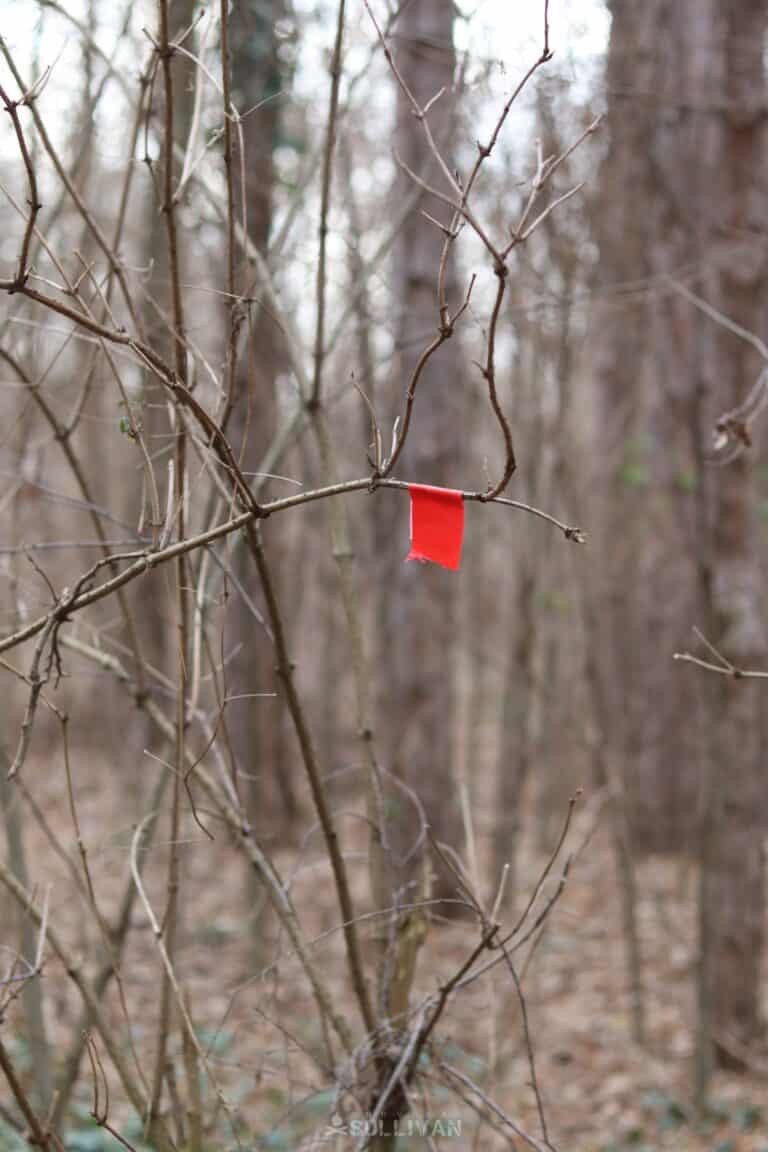
If you have no clothing to spare, use sticks to form the shape of a directional arrow. If no sticks are available then arrange small pebbles in a directional arrow or simply pile three rocks on top of each other at intervals as you wander.
Three is the universal signal for distress. If there are no twigs or rocks and you are in grassland then tie knots in the living grass at intervals as you progress.
Gunshots
If you have a gun and some ammo, fire three shots in the air. Only do this if you are desperate, and have enough ammunition as you may need this to ward off animal attacks.
Striking Rocks Together
Help guide rescuers by striking rocks together at intervals – three strikes at a time to signal distress.
Small Model Boats Made of a Large Leaf or Bark
If you can fashion a large leaf into a boat shape or scratch SOS or your name onto a piece of bark and float it down river you can attract attention. Remember to make lots of these, as many will get stuck along the way, ending up in eddies going upstream, or get lodged in vegetation.
The more you make, the more chances of being rescued. Then stay near the river because rescuers will come upstream – unless of course there is danger of flooding, in which case you should remain within sight of the river but on higher ground.
Snow melt and rains can cause rivers to rise rapidly. The leaves can be fastened with a thorn or a small twig to form the boat shape – as long as it looks like a human has made it you have a chance of someone noticing.
You can also float small rafts made of reeds downstream to which you have fastened a small piece of your clothing to attract attention.
Learn more about signaling in our other article.
Basic Knots
When you are surviving in the woods you will rely on knots for various uses – fastening a structure together, creating snares, fastening fishing line to a hook, tying up your tarp to a tree, and much more. Here are the most important knots needed for most survival situations.
You may be practicing for a sustained stay in the woods as an alternative lifestyle, or simply honing your skills in case of SHTF scenarios.
Something to keep in mind: much of the forested area of the U.S. is owned by the federal government (the U.S. Forest Service), so if you want to stay there legally, you will have to get a permit for a few days at a time.
However, if you have permission to stay on privately owned land, you can stay there as long as the owner permits you to. Some people buy their own land on which to hone their survival skills.
Avoiding Animal Attacks
The best way to avoid attack is to take the operative word ‘avoid’ into consideration. Animals are usually going about their own business, and don’t particularly want to cross paths with humans, however if they have learned that humans provide an easy source of food, then you may have trouble.
The smell of cooking food draws in predators. If you want to keep safe cook quickly then dispose of the remains by burying, do not take food into your tent / tarp or constructed shelter but cache it securely elsewhere, well away from where you are sleeping.
In South Africa, there was a case where teens on a wilderness camp did not heed the advice of the rangers to have no food whatsoever in their tents.
A youngster who had secreted food in the tent was bitten in the face by a hyena that followed the scent of food. Wash your hands and brush teeth to make sure the smell of meat does not remain on you before sleeping. If you feel it is necessary keep a fire burning at night.
Bears
When you are surviving in the woods you are just another animal in the woods, and animals only stay alive by being constantly alert. When moving around, always make sure you know what is behind and in front of you.
Use your peripheral vision to scan the sides when you are walking. Look out for bear tracks, and bear scat. Avoid areas where they are likely to feed (such as berry patches), or stream banks where they come to drink.
If you encounter a bear on a trail ease back and give the bear room to go about its business – find yourself another route, or if there is not alternative, settle down to wait well out of the way until the bear has wandered off the particular route you want to take.
Bears who have learned that campers keep food in their tents will not be reticent about coming in and helping themselves, and if you happen to be in the way, or object to their taking ways, you could end up injured.
Bear spray will help dissuade a bear that insists on hanging around your camp, or that wants to attack on your meanders through the woods.
Mountain Lion
The mountain line, or cougar, is North America’s largest feline species, and though their current day numbers are a fraction of what they once were they are still present in many woodland regions around the nation.
Highly reclusive, they are rarely seen and attacks on humans even rarer. That being said, you don’t have to look very hard to read a harrowing tale of a hiker or camper being stalked by one of these big cats.
Potentially weighing upwards of 200 lbs, tangling with one of these ticked off kitties is a great way to get cut to ribbons.
Superb ambush predators, a mountain lion will try to pounce on unaware and unassuming prey before dispatching it with a bite to the neck.
You might be able to fend off a mountain lion by confronting it with a defensive display, but don’t be surprised if it lurks in the shadows or stalks you for miles down the trail, waiting for another chance.
Wolves
There are plenty of good tips in this video. Basically it comes down to avoiding eye contact, showing submission, and not to run, but to back away carefully.
If attack seems imminent then to throw objects at the wolf in an attempt to dissuade it, and if you are in a group to make sure children or the elderly – the most vulnerable – are not left alone.
Moose
While most creatures like deer and elk will move away from humans, a bull moose may not be as accommodating.
Moose can give chase, and weighing in at well over a ton can be intimidating and dangerous, so give them their space. There is no need to get up close and confrontational. At least they can’t climb trees, so if you are able, shimmy up the nearest suitable tree.
A cow with young or a bull during the rut are particularly unpredictable and dangerous, and don’t let their size fool you: they can accelerate to top speed in seconds and bulldoze vegetation out of the way in order to reach you.
We put together a list of even more animals to watch out for in the wild here.
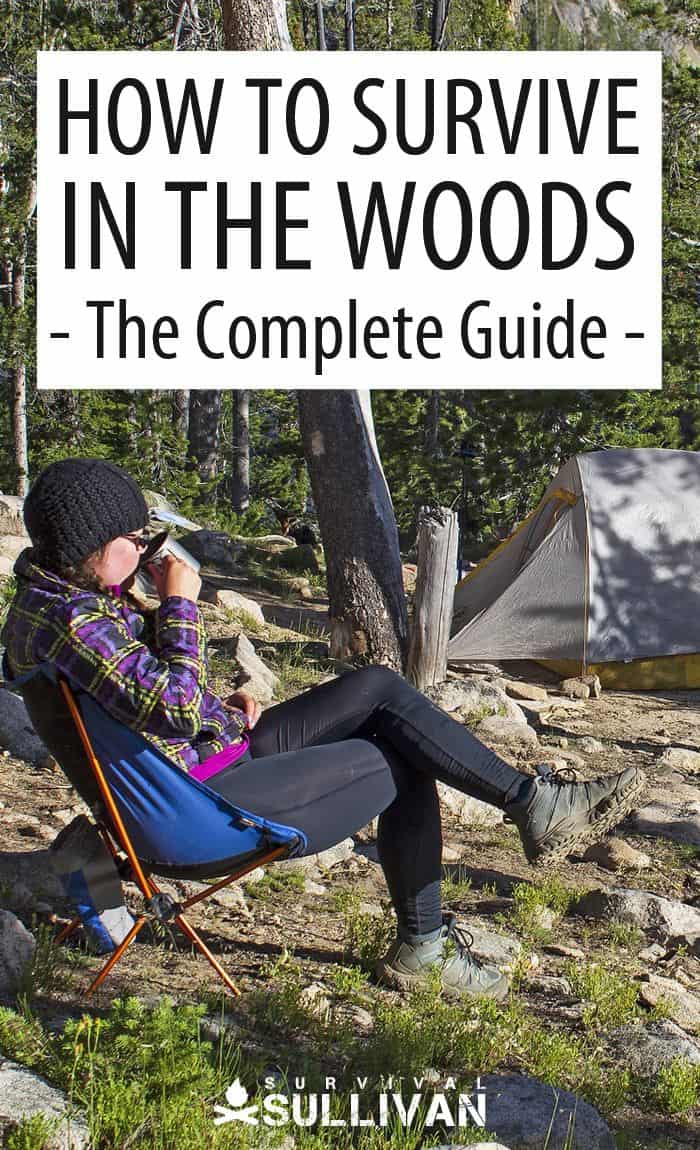

Traveler, photographer, writer. I’m eternally curious, in love with the natural world. How people can survive in harmony with nature has fueled my food safety and survival gardening practices.
At the age of 12, I found a newspaper advertisement for a 155-acre farm at a really good price and showed my parents one Sunday morning. They bought it and I happily started planting vegetables, peanuts, maize and keeping bees with the help of the local labor.
Once I married wherever we moved it was all about planting food, keeping chickens and ducks, permaculture and creating micro-climates. I learned how to build wooden cabins and outdoor furniture from pallets, and baked and cooked home-grown produce, developing recipes as I went along.
